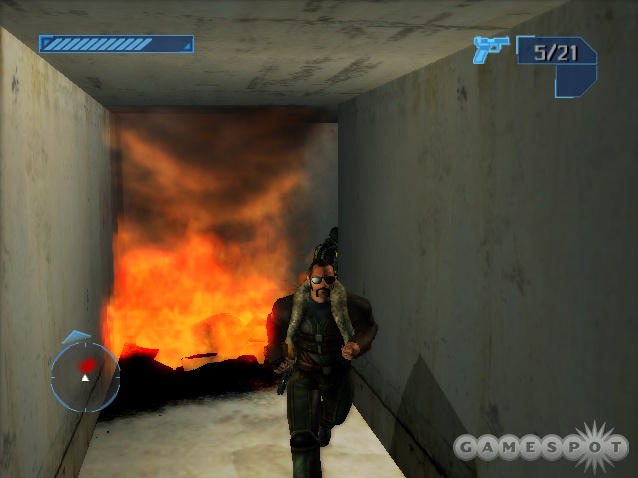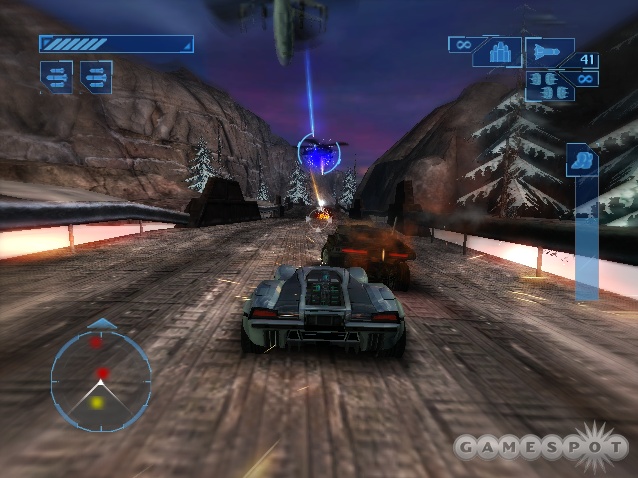Spy Hunter: Nowhere to Run is a bit of an anomaly. It was developed as the game tie-in for a motion picture inspired by the Spy Hunter franchise, with Dwayne "The Rock" Johnson starring in both. As of this writing, though, the Spy Hunter motion picture is nowhere to be seen, making it seem arbitrary that Midway would release a new Spy Hunter game featuring The Rock. Even if it weren't saddled with all this snake-eating-its-own-tail distraction, Nowhere to Run is such a derivative, uninspired mash of third-person action and driving sequences that it still feels unnecessary.

The last two Spy Hunter games concerned themselves with taking the dynamics of Midway's classic driving-and-shooting arcade game and updating them for modern audiences. Some of the work from those games still comes through in Nowhere to Run, but surprisingly, you don't spend very much time behind the wheel of the tricked-out Interceptor vehicle, which takes a backseat to loads of generic third-person action. You play as Alex Decker, an agent working for the frankly named International Espionage Service, and the driver of the Interceptor. Within the first few minutes of the game, the Interceptor gets stolen out from underneath you by the predictably sinister criminal organization NOSTRA, and much of the next several hours are spent trying to recover the Interceptor. Even after you recover the Interceptor, though, you still end up spending the majority of your time walking through nondescript corridors and shooting at generic thugs.
Despite bearing a passable resemblance to The Rock, Alex Decker has a whole lot more in common with Halo's Master Chief. His health bar will regenerate to a certain extent if you can avoid damage for a few seconds, and he can carry only two weapons at a time, regularly forcing you to decide between machine guns, submachine guns, shotguns, and rocket launchers. When he runs out of ammo, though, Alex can throw down with his bare fists. He has a couple of different punches, as well as the ability to pick up and toss enemies; but all of that might as well not even be in the game, thanks to a suite of WWE-style finishing moves. By holding down the strong punch button, you can perform a stun punch, which leaves your opponent dazed, at which point you can tap any of the face buttons to perform the finisher. Since there's no recharge time on the finishers or the stun punch, you can just perform these two moves over and over again. Even though the artificial intelligence is pretty stupid, often facing the wrong way in the middle of a gunfight or simply not reacting to your presence at all, it often makes up for that stupidity with sheer numbers, and the actual gunplay doesn't feel entirely bad. The fistfighting, though, just doesn't seem very well thought out.
There's usually some kind of secondary objective of planting explosives or rescuing injured IES agents during these third-person action sequences, and there are a few sequences in which you have to man a turret or solve a couple of simple logic puzzles, but mostly you'll be concerned with walking into rooms filled with henchmen, killing all the henchmen, and moving on to the next room. With the exception of some really stubborn spider tanks that you'll run into later in the game, and two suspiciously similar boss fights, there's never much variety to the villains you'll be fighting, or to the action itself. In occasional short stretches between these standard action-man sequences, you'll actually drive the Interceptor, a versatile vehicle that, when the situation calls for it, is able to take on the form of a car, a boat, or a motorcycle.
Absurd as it might seem to make a Spy Hunter game that doesn't focus almost entirely on driving and shooting, Nowhere to Run probably isn't any worse off for it, since the different vehicular controls alternate between loose and touchy, and there's too much computer assistance for the shooting to feel very satisfying. What's really frustrating about Nowhere to Run is that it almost always cuts away to a muddy cinematic right before all of the coolest action sequences, like when you fly the Interceptor head-on into an enemy helicopter, or use your rockets to blow a hole in a wall just seconds before you would smash into it. One of the fundamentals of video games is that it's more fun to do than it is to watch, a concept seemingly lost on Nowhere to Run. To its credit, though, the transitions between the on-foot and the vehicular missions are often seamless, and the pacing is quite unrelenting, with not so much as a mission summary or debriefing screen between levels.

Being in the midst of a console hardware transition, PlayStation 2 and Xbox games have to work hard to impress, but Nowhere to Run seems content with doing just barely enough. Though you seem to be fighting the same half-dozen thugs, boats, and cars for the duration of the game, there are some good scenery changes, including a wide variety of high-tech, secret military installations, burned-out warehouses, opulent mansions, and canal-lined European streets. Alex Decker looks and sounds enough like The Rock, though the character model is a bit blocky, and The Rock is given few lines that make good use of his inherent charisma. The game's whole look just feels as though it was cribbed from other familiar, better games--games that weren't plagued with repetitive character designs, awkward rag-doll deaths, cheap-looking special effects, and inconsistent frame rates. Maybe more appalling to Spy Hunter fans than the second-class treatment given to the driving sequences is the fact that the Peter Gunn theme song, which has been a Spy Hunter staple since the beginning, is seemingly nowhere to be found in Nowhere to Run.
Nowhere to Run seems as though it was designed less as a natural continuation of the Spy Hunter franchise and more as an action vehicle for The Rock, and it feels like an awkward pairing. It gets a few things right, but the game overextends itself, and in the process of trying to be both a third-person action game and an action-packed driving game, it does neither well.